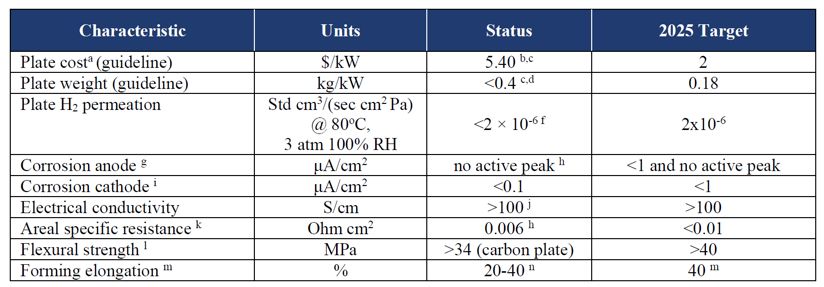Email: info@karssenmetal.com Tel: +86 18147353336
At present, the application of fuel cell systems in the market is mainly commercial vehicles, and the core component of fuel cell stacks is mainly graphite bipolar plate stacks. From the perspective of future development, graphite bipolar plates will still occupy a larger share of the commercial vehicle market for a long time. So why does the graphite bipolar plate occupy such a large market share, and how does it change from graphite to bipolar plate step by step?
According to the "Fuel Cell Technical Team Roadmap" report issued by the US Department of Energy in 2017, the requirements for the performance of fuel cell bipolar plates can be seen in the following table:

The cost, mechanical properties, air permeability, corrosion resistance, electrical conductivity and surface contact resistance of bipolar plates are strictly required as the core indicators of bipolar plates. Therefore, the selection of raw materials for graphite bipolar plates and the processing technology affect whether it can meet the needs of the final target market.
Raw materials
Different manufacturers have different processes for making graphite bipolar plate. The main materials include graphite materials, resin impregnated materials, cured materials, etc. According to different graphite plate processes, the types, materials, specifications and grades of raw materials are greatly the difference.
According to different process requirements, graphite can be made into powder, coil, sheet and emulsion, but its raw materials are mainly divided into three categories:
Graphite powder: a substance with a very sensitive chemical reaction, its resistivity will change in different environments, depending on whether the graphite powder can ensure the uninterrupted graphite powder in an insulating object. High temperature resistance, chemical stability, plasticity and thermoplastic resistance are all good.
Expanded graphite: a loose and porous worm-like substance obtained from natural graphite flakes through intercalation, water washing, drying and high temperature expansion. In addition to the excellent properties of natural graphite itself, it also has the characteristics of softness, compression resilience, adsorption, and radiation resistance that natural graphite does not have. Expanded graphite can instantly expand 150-300 times in volume when exposed to high temperature.
Flake graphite: It is a natural crystalline graphite with complete crystallization. It is shaped like a fish phosphorus, belongs to the hexagonal crystal system, has a layered structure, is thin and has good toughness, excellent physical and chemical properties, and has good thermal conductivity, electrical conductivity, thermal shock resistance, corrosion resistance, etc.
Continuous production process
The continuous production and processing of graphite bipolar plates is mainly divided into two categories, one is the plate molding process of expanded graphite composite materials, and the other is the molding/injection molding process of graphite powder resin composite materials.
The source cited the analysis report of the two types of processes published by AFCC in Canada in 2017:
Category 1: The expanded graphite sheet is calendered, formed and removed, and then enters the resin impregnation, vulcanization, bonding and sealing vulcanization process, and finally forms a bipolar plate product.
At present, this process has the following characteristics:
1. It can well meet the requirements of the shape, surface geometry and mechanical size of the plate;
2. Due to the continuity of the expanded graphite material, it has high electrical and thermal conductivity;
3. The surface hydrophobicity needs need to be solved by co-processing of the process and materials;
4. If the rolling process is used, its design accuracy and process accuracy should be further improved;
5. Post-processing of mold clamping pressure, resin ratio and surface contact resistance is the key to affecting the performance of the electrode plate;

Category 2: First, to prepare the mixed material of graphite powder and resin, and then pretreat the mixed material and mold before molding, followed by molding and vulcanization, and finally bonding, sealing and curing to form a product.
At present, the process has the following characteristics:
1. It can well meet the requirements of the shape, surface geometry and mechanical size of the plate;
2. Since the mixed particles block the continuity of the graphite material, the conductivity should be further improved under high current;
3. To meet the needs of surface hydrophobicity, it needs to be solved by co-processing of processes and materials;
4. The ratio and selection of resin, vulcanization time and post-treatment of surface contact resistance are the keys to affecting the performance of the electrode plate.

Judging from the current development of the hydrogen energy industry, the production process of the bipolar plate has progressed rapidly. The transformation of the traditional graphite industry and related manufacturing industries has provided a great help for the production of fuel cell bipolar plates. May fuel cells can enter thousands of households as soon as possible.
Isostatic graphite blocks are an important graph
Graphite rotor belongs to graphite material, whi
Graphite sheets have many important roles in the
Contact: Bateer
Phone: +86 18147353336
Tel: +86 18147353336
Email: info@karssenmetal.com
Add: Room D204-2203, Innovation Building, Baotou Light Industry Vocational Technical College, 19 Jianhua Road, Qingshan District, Baotou City, Inner Mongolia, China.